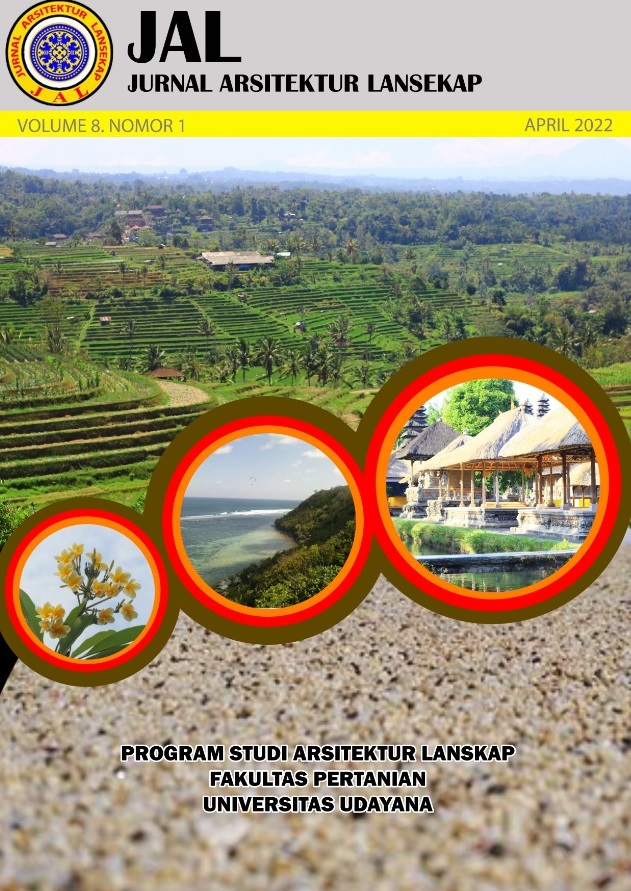Konsep Hidden Layer pada Perancangan Taman Brumbungan Kota Semarang
Abstract
Hidden layers concept in the design of the Semarang City Brumbungan Park. Brumbungan Park is an open space located on Jalan Pringgading, Central Semarang District, Semarang City. The Location of Brumbungan Park in the previous condition was a vehicle parking area for culinary stalls in the vicinity. In 2016 there was a discourse to restore this park according to its function as a city park and green open space. The Central Java Environmental and Building Arrangement Work Unit in collaboration with the Central Java Regional Indonesian Architects Association held a green open space design competition to produce designs that could be implemented in the park. The Brumbungan park design that is offered tries to answer the problems and issues that occur around the park, as well as being able to accommodate various functions and activities in the park. The methodology used in this study are qualitative method by data inventory, analysis and synthesis then design concept determination and development. The result of the planning is the Hidden Layer of Semarang design concept, which means that even on a small scale, this new garden design is expected to contribute to green open spaces in Semarang, set a precedent, open new discourses, and become a catalyst for the development of parks and open spaces. Physical implementation of the concept, this park will be hidden and surrounded by vegetation (hidden layer) so that the facilities will be enjoyed while in the park.
Downloads
References
Dirjen Tata Ruang. (2021). Ruang Terbuka Hijau Tak Sampai 10 Persen. Kementerian Agraria Dan Tata Ruang. https://tataruang.atrbpn.go.id/Berita/Detail/479 (diakses pada 20 August 2021).
Dwipayana, I. G. N. M., Kohdrata, N., & Suyarto, R. (2021). Studi jangkauan layanan Taman Kota Lumintang, Denpasar, Bali. Jurnal Arsitektur Lansekap, 7(1), 85. https://doi.org/10.24843/jal.2021.v07.i01.p09
Dwiyanto, A. (2009). Kuantitas Dan Kualitas Ruang Terbuka Hijau Di Permukiman Perkotaan. Jurnal Nasional Arsitektur, 30(2), 88–92. https://doi.org/10.14710/teknik.v30i2.1861
Gold, S.M. (1980). Recreation Planning and Design. McGrawHill Company. New York
Maurer, M., Zaval, L., Orlove, B., Moraga, V., & Culligan, P. (2021). More than nature: Linkages between well-being and greenspace influenced by a combination of elements of nature and non-nature in a New York City urban park. Urban Forestry and Urban Greening, 61, 127081. https://doi.org/10.1016/j.ufug.2021.127081
Permana, I. A., & Fatimah, I. Si. (2017). Redesign Taman Kota Kabupaten Bogor Dengan Pendekatan Urban Landscape Design. Jurnal Arsitektur Lansekap, 3(1), 39. https://doi.org/10.24843/jal.2017.v03.i01.p05
Pemerintah Kota Semarang. (2021). Profil Kembali Menu Utama. https://semarangkota.go.id (diakses pada 21 August 2021)
PSUD. (2021). Urban design The Indonesian Experience. PT Imaji Media Pustaka, Jakarta
Siregar, H. H., & Kusuma, H. E. (2015). Tingkat Kenyamanan Taman Kota sebagai Ruang Interaksi- Masyarakat Perkotaan. Jurnal Temu Ilniah IPLBI 2015, Tingkat Kenyamanan Taman Kota, 162–166.
Sudarwani, M. M., & Ekaputra, Y. D. (2017). Kajian Penambahan Ruang Terbuka Hijau di Kota Semarang. Jurnal Teknik Sipil Dan Perencanaan, 19(1), 47–56. https://doi.org/10.15294/jtsp.v19i1.10493
Syahadat, R. M., Putra, P. T., Alfian, R., & Nailufar, B. (2016). Mengembalikan Mata Air Umbulan , Menyelamatkan Sense Masyarakat Lokal Mengembalikan Mata Air Umbulan , Menyelamatkan Sense Masyarakat Lokal. TEMU ILMIAH IPLBI 2016, October.
Widjajanti, W. W. (2013). Keberadaan dan Optimasi Ruang Terbuka Hijau Bagi Kehidupan Kota. Jurnal ITATS, 1–7. http://jurnal.itats.ac.id/keberadaan-dan-optimasi-ruang-terbuka-hijau-bagi-kehidupan-kota/

This work is licensed under a Creative Commons Attribution-ShareAlike 4.0 International License.
An author who publishes in the Jurnal Arsitektur Lansekap (JAL) agrees to the following terms:
- Author retains the copyright and grants the journal the right of first publication of the work simultaneously licensed under the Creative Commons Attribution-ShareAlike 4.0 License that allows others to share the work with an acknowledgement of the work's authorship and initial publication in this journal
- Author is able to enter into separate, additional contractual arrangements for the non-exclusive distribution of the journal's published version of the work (e.g., post it to an institutional repository or publish it in a book) with the acknowledgement of its initial publication in this journal.
- Author is permitted and encouraged to post his/her work online (e.g., in institutional repositories or on their website) prior to and during the submission process, as it can lead to productive exchanges, as well as earlier and greater citation of the published work (See The Effect of Open Access).
Read more about the Creative Commons Attribution-ShareAlike 4.0 Licence here: https://creativecommons.org/licenses/by-sa/4.0/.







